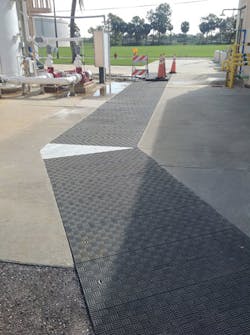Material Alternative to Conventional Access Covers
By Bethany DeGraff
Composite materials are in huge demand as industries across the globe are experiencing hazards and injuries when using traditional steel and other metal products. Reports of crushed and amputated fingers and toes along with burns, back injuries and other dangers have given industries ranging from data centers to water treatment plants a reason to seek safer alternatives.
According to the 2014/15 U.S. Bureau of Labor Statistics, there were 3,675 incidences of reported injuries within the manufacturing industry alone.¹ Of these, 32 percent were back injuries, totaling 125,880 missed working days,2 and legislation continues to restrict acceptable manual weights. Composites are an ideal solution to these problems due to their lightweight yet durable properties.
Hazards and Injuries
One particular area experiencing a major shift is in manhole covers and trench covers, where chances of injury during installation and removal are traditionally extremely high. For example, conventional steel manhole and trench covers typically weigh more than three times that of a composite cover, requiring the use of large machinery to move and adding to the safety risks already in place. These steel covers also lack temperature control, which can make the surface extremely hot, resulting in severe burns when stepped on without proper attire. This presents a hazard in public spaces such as university campuses, shopping centers, and municipalities where heavy foot traffic is commonplace.
Composites and Covers
Traditional metal or concrete access covers are heavy and may even require specialist equipment, making lifting time-consuming and expensive. Using composite materials eliminates the use of heavy lifting equipment, allows for safer manual handling and avoids the high risks of injuries. Fibrelite, a leading manufacturer of composite covers and trench panels, has responded by using fiber-reinforced plastic composite (FRP), a type of composite material, in order to provide a safe and risk-free alternative. Fibrelite’s FRP covers have been designed to eliminate risk of burns by limiting high temperatures on the surface regardless of the temperatures below the cover. As an added safety feature, they also include an anti-slip/skid surface that reduces falls, slipping and sliding.
“As well as being lightweight - typically a third of the weight of metal or concrete - our covers are designed for safe lifting, having up to two lifting points for ergonomic lifting handles, which means that just one or two operatives can move them quickly and easily without risk of back injury or crushed fingers or toes, even at the heavier load ratings,” explained David Holmes, Fibrelite technical director.
While not every application currently requires the composite alternative, the costs of metal theft, manual handling injury claims and corrosion are causing many industries to rethink traditional materials and consider the use of modern composite products instead of conventional steel or other metal products. Because of this, other industries are following Fibrelite’s lead and are incorporating composites into their products as they react to changing regulations and strict health and safety policies, and are becoming more concerned with product maintenance costs. Although FRP composite can be more expensive than traditional materials such as aluminum, steel and concrete, composites are becoming more favorable where corrosion resistance, safety, thermal conductivity and other performance essentials are critical to a specific application.
About the Author: Bethany DeGraff is the North American marketing specialist for Fibrelite and OPW Global, a Dover Company. To learn more, visit www.fibrelite.com.
References
1. “Occupational Injuries/Illnesses and Fatal Injuries Profiles,” US Bureau of Labor Statistics, accessed March 16, 2016. http://data.bls.gov/gqt
2. “Nonfatal Occupational Injuries and Illnesses Requiring Days Away From Work, 2014,” U.S. Bureau of Labor Statistics, accessed March 16, 2016. http://data.bls.gov/gqt

